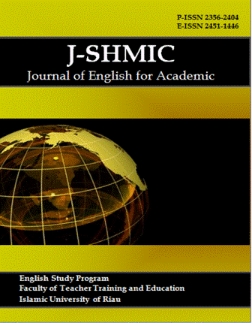Students’ Perception of Using Socrative in Learning Grammar at the English Study Program of FKIP UIR: A Case Study at the Second Year Students
Keywords:
Socrative, Grammar, Students’ PerceptionAbstract
The main objective of this study is to identify students' perceptions of the implementation of socrative learning grammar. The second-year students of the English Department of FKIP UIR in the academic year 2018/2019 were the objects of this research. Questionnaires and interviews as a tool to collect data for this study. The questionnaire was adapted from the TAM theory (David, Bagozzi & Warshaw, 1989) which included 20 closed questions relating to the perceived usefulness and perceived ease of use of using socrative in learning grammar. The data in this study was analyzed using quantitative and qualitative analysis. While data from the interview were transcribed. The results of this study indicated that students have positive perceptions about the use of socrative. The results of this study also proved that students have a positive view of the use of socrative in learning grammar. This means that they accept the use of socrative in the learning process
Downloads
References
Ajzen, I & Fishbein, M 1980, Understanding attitudes and predicting social behavior, Prentice-Hall., NJ
Creswell, J. W., Clark, V. L. P. (2007). Designing and conducting mixed methods research. Retrieved December 10, 2017, from : cirt.gcu.edu
Dakka, S. M. (2015). Using socrative to enchance in class students engagement and collaboration, 4(3), 13–19
.
Daneshgar, F., Aurum, A., & Potukuchi, S. (2007). Adoption of instant messaging technologies by university students. ACIS 2007 Proceedings, 70.
Debata, P. K., Phil, M., & Ph, D. (2013). The Importance of Grammar in English Language Teaching - A Reassessment, 13(May), 482–486.
Dervan, P. (2014). Enhancing In-class Student Engagement Using Socrative ( an Online Student Response System ): A Report ., 6(3).
Dholakia, R. R., & Dholakia, N. (2004). Mobility and markets: emerging outlines of m-commerce. Journal of Business research, 57(12), 1391-1396.
Dickinger, A., Arami, M., & Meyer, D. (2006, January). Reconsidering the adoption process: enjoyment and social norms—antecedents of hedonic mobile technology use. In System Sciences, 2006. HICSS'06. Proceedings of the 39th Annual Hawaii International Conference on (Vol. 1, pp. 23a-23a). IEEE
Drexler, W. (2010). The networked student model for construction of personal learning. Language Learning & Technology, 26(3), 369-85
Davis, F. D. (1989). Perceived usefulness, perceived ease of use, and user acceptance of information technology. MIS Quarterly 1989, 13(3), 319–340
Effendi, M. S., Rokhyati, U., & Rachman, U. A. (2017). A Study on Grammar Teaching at an English Education Department in an EFL Context, 5(1), 42–46.
Edens, K. M. (2009). The interaction of pedagogical approach, gender, self-regulation, and goal orientation using student response system technology. Journal of Research on Technology in Education, 41(2), 161-177
Ismail, S. A. A. (2010). ESP students’ views of ESL grammar learning. GEMA Online Journal of Language Studies, 10(3), 143–156.
Ira Irza, L. (2013). Using Webquest in Learning Grammar : Students ’ Perceptions in Higher Education. 4(1). https://doi.org/10.7575/aiac.alls.v.4n.1p.13
Khan, R. N. (2007). Effective Grammar Teaching in EFL Classroom. Bachelor of Arts in English, BRAC University, Bangladesh.
Larsen-Freeman, D. (2003). Teaching grammar: From grammar to grammaring. Boston: Heinle and Heinle
Kaya, A., Balta, N. (2016). Taking Advantages of Technologies: Using the Socrative in English Language Teaching Classes. International Journal of Social Sciences & Educational Studies, Vol.2, No.3. Turkey
Mork C, M. (2014). Benefits of using online student response systems in Japanese EFL classrooms. The JALT CALL Journal. Vol. 10, No.2 Pages 127–137. Tokyo Woman’s Christian University.
O’Keeffe, M. (2012). Enhancement of learning with classroom response systems (clickers) – Lecturer reports and feedback. Dublin Institute of Technology. Available at http://www.dit.ie/lttc/media/ditlttc/clickers/Clicker_report_July_2011.pdf. [Retrieved on 05/05/2019
Radner, R., Rothschild, M. (1975). On the Allocation to Effort. Journal of Economic Theory. (10), pp. 358-376
Rogers, E. (1995). Diffusion of innovations (4th ed.). New York: The Free Press
Terrell, S. S. (2013). Integrating online tools to motivate young English language learners to practice English outside the classroom. In B. Zou (ed.), Explorations of Language Teaching and Learning with Computational Assistance (pp. 184-192). Hershey, PA: IGI Global.
Teo, T. S. (2001). Demographic and motivation variables associated with Internet usage activities. Internet Research, 11(2), 125-137.
Xin, Z. (2010). Grammar learning and teaching: Time, tense and verb. US – China Review. 1-9.
Widodo, H. P., Program, T. E., Negeri, P., & State, J. (2006). Approaches and procedures for teaching grammar, 5(1), 122–141.
Published
How to Cite
Issue
Section
This is an open-access article distributed under the terms of the Creative Commons Attribution-ShareAlike 4.0 International License which permits unrestricted use, distribution, and reproduction in any medium. Users are allowed to read, download, copy, distribute, search, or link to full-text articles in this journal without asking by giving appropriate credit, providing a link to the license, and indicating if changes were made. All of the remixes, transform, or build upon the material must distribute the contributions under the same license as the original.











